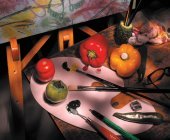|
Tripod and Camera StandThere are variety of models available for camera support in form of a tripod. Considerations for selection are: Head - Pan and tilt head or Mono ball head Center Column - Column adjustments with helical gear, rack and pinion or direct tightening Reversibility of centre column Height
Pan and tilt head: This is a standard version of a tripod head, which has separate handles to tighten horizontal and vertical movements. Since it has separate handles, each movement can be individually controlled.
Advantage with this head is, we can move the camera on horizontal axis (for panning) without tilting the camera or tilt it in vertical direction without a horizontal movement. This head is mostly used in studio and for architectural photography. Mono ball: This type of head design has only one knob. So all movements can be controlled at once by loosening one single knob, but at the same time, if we want to move the camera in any one direction, (pan or tilt), it is difficult. Advantage of this design is, as we are handling only one knob, we can frame the subject much faster. A great help when we are doing a sports or a wild-life action shoot. Both type of heads may have a quick camera release mounting plate or direct mounting plate, depending on the product design. Both will provide a firm camera support. (Quick camera release mounting is preferable when we are using two or more cameras for a shoot. With one single action on the release lever, we can remove the camera from the stand. Additional plates are available which are to be fixed on each camera body.) Center Column: Column height adjustments are either with helical gear, rack and pinion or direct. Helical gear is a sturdiest design and will not let the column drop, even if the lock is released. Fine adjustment of height is possible. It is a costly, but durable mechanism. Rack and pinion is a common design, found in most of tripods. Fine adjustments are possible but camera may drop when we loose the lock. So we must hold the crank lever of the stand while operating. Direct tightening of center column is provided in cheaper version of tripods. We must hold the camera while adjusting the height of the column or the camera will drop. Fine adjustment of height is not possible with this design. Reversibility of center column: Helical gear design will not allow us to remove the center column and use it upside down. Additional screw is provided on the bottom end of the column, so that we can remove the head from top and mount it on the bottom for a very low angle shoot. Rack and pinion may or may not give this facility of reversing the column, depending on the design of a model. Direct tightening designs are for quick reversing of center column, depending on a design. Good quality stand offers other accessories like horizontal extension arm and interchangeable head. Horizontal extension arm is required when you want to shoot a subject from top angle. The extension will keep the tripod legs far from the frame. Additional safety lock is given on quick release lever to prevent any accidental release. Height: Consider maximum height, at which the stand can be operated. Heavier design can provide good support at more heights exceeding 10 feet. We may need a spare head, if we have one large format camera and other small one. Or, if by accident, we have damaged the head, then we can just replace the head without spending for legs. A good suggestion, buy the costliest stand you can afford. It is one time investment, which we can use for years. Never give your stand to anybody. One wrong twist or turn of any knob, and your stand is permanently damaged.
|






